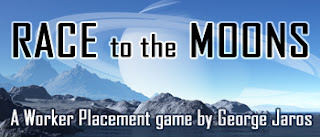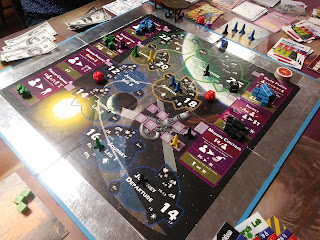Availability: The Game Crafter
Status: Pitching
Contests:
July 2016 - 24 Hour Contest Entry - WINNER
June 2017 - The Game Crafter Big Box Challenge - Semi-Finalist
Status: Pitching
July 2016 - 24 Hour Contest Entry - WINNER
June 2017 - The Game Crafter Big Box Challenge - Semi-Finalist
You can download the Full Rules from the Game Crafter: https://www.thegamecrafter.com/games/race-to-the-moons
Protospiel Tested
Protospiel Tested
The year is 2169 and mankind has pretty much filled up the Earth. It has been 200 years since man first set foot on the Moon. Now there are cities on the Moon and Mars, and mining communities in the asteroid belt. But our Solar System is just the beginning. It might be home, but Earth is the only truly hospitable planet nearby. However, recent breakthroughs in warp travel mean that interstellar voyages are finally a reality.
There are several extrasolar systems that have been discovered to have planets and moons which appear to be very Earthlike, and likely hospitable. The nearest of these is in the Gamma Leporis tri-star system, 29 light years away from Earth. A series of moons orbiting a gas giant named Yutu show breathable atmospheres, tolerable radiation levels, reasonable temperatures, liquid water, and plenty of land. Now, the race is on. Terran, Lunar, Martian, and Belter organizations are competing to be the first to send humans to one of these habitable moons and establish a permanent human colony. It will take research, determination, and a bit of luck to be the first to arrive. Do you have what it takes to drive the next great space triumph and win the Race to the Moons?
There are several extrasolar systems that have been discovered to have planets and moons which appear to be very Earthlike, and likely hospitable. The nearest of these is in the Gamma Leporis tri-star system, 29 light years away from Earth. A series of moons orbiting a gas giant named Yutu show breathable atmospheres, tolerable radiation levels, reasonable temperatures, liquid water, and plenty of land. Now, the race is on. Terran, Lunar, Martian, and Belter organizations are competing to be the first to send humans to one of these habitable moons and establish a permanent human colony. It will take research, determination, and a bit of luck to be the first to arrive. Do you have what it takes to drive the next great space triumph and win the Race to the Moons?
Overview:
Race to the Moons is a worker placement game where 2-5 players (solo variant included) are working to research the technology needed to complete an interstellar mission and be the first to found a human colony on a moon system around a gas planet in another solar system. Players must research four technologies that affect four parts of the mission: Launch, Journey, Arrival & Landing, and Colonization. Players must also work on building ships, building facilities (research, factories, launch stations, and more), managing money, and improving public opinion. Players must successfully build and launch ships, develop technology, have a successful journey, arrive at the destination, and set up a successful colony to earn enough points to beat the competition.
Gameplay:
The game is played in a series of rounds. Each round consists of two phases:
Phase 1 – Worker Placement
Take turns assigning workers to one of seven different Actions. You can place as many workers on an Action as that Action allows. Immediately after placing the workers you must pay the cost to gain the benefit of that Action. If you are the first player to use an Action each round, you will get an extra bonus. If you cannot pay the cost of the Action you may not take it. You may not take an Action you have already taken this round.
Actions include:
- Research - Increase your Technology and earn patents.
- Production - Build rockets and mission-critical resources.
- Upgrade Facilities - Get better factories, research labs, launch stations, etc.
- Publicity Campaign - Spend money to increase popularity, which earns you more workers.
- Raise Funds - Gain money and increase income.
- Invest - Earn money and gain other benefits, including outsourcing rocket production to get cheaper rockets by waiting.
- Mission Command - Allows you to launch rockets and progress through your mission to colonize the moons.
Phase 2 – End of Round
At the end of the round there are a few steps that must be taken by all players:
- Revenue - gain income.
- License Technology - sell technology to other players.
- Advance Production Outsourcing - Outsourced rockets get closer to completion.
- Advance Rockets
- Advancing Rockets in their mission is the key step in Phase 2. This is where players get closer to being able to colonize the moons of the Gamma Leporis System.
- Players roll dice depending on their technology level in each of three mission stages: Journey, Arrival & Landing, and Colonization. Higher tech gives you a better chance at success in each stage, but space flight is still risky.
- Spending Resources and Save the Day tokens can help mitigate risky situations.
- Retrieve Workers
Game End
The game ends at the end of the round when one player successfully colonizes. Then points are tallied:
- Points Earned Per Rocket Per Location. Closer to Colonization earns more points.
- 1 point per active, constructed rocket
- 2 points for Popularity = 15
- 2 points per Technology Level at Level 8
- 2 points per Proprietary Technology Certificate owned
- 1-5pt Bonus for Entrepreneurs – the player(s) with the most money.
If there is a tie the winner is the player with the most rockets closest to Colonization. If there is still a tie the winner is the player with the most money.
When totaling up scores, use the Score Tracker side of the Reference Board and one piece of each player’s color.
PnP Files:
Support me on Patron!
You can download the Full Rules from the Game Crafter: https://www.thegamecrafter.com/games/race-to-the-moons






















No comments:
Post a Comment